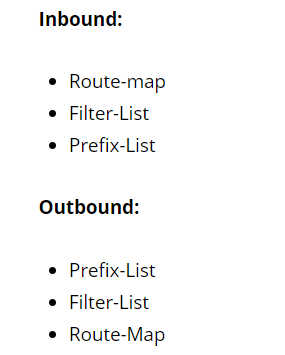This topic is to discuss the following lesson:
Hi Rene,
I think that it is a errata:
This prefix-list checks the entire 2001::/16 range and permits subnets with a /64 or larger.It should be:
This prefix-list checks the entire 2001::/16 range and permits subnets with a /64 o smaller
Thanks you
Hi Diego,
Thanks for the message, this sentence is correct though. Take a look at the prefix-list:
ipv6 prefix-list SMALL_NETWORKS permit 2001::/16 le 64
The “le 64” part means that it will match /64, /63, /62, /61, /60, etc. All of these are “larger” subnets than /64.
Rene
Hi Rene
Great lesson!
you might want to fix the BGP configuration for R2
R2(config)#router bgp 1
R2(config-router)#bgp router-id 2.2.2.2
R2(config-router)#neighbor 2001:db8:0:12::1 remote-as 2
R2(config-router)#address-family ipv6
R2(config-router-af)#neighbor 2001:db8:0:12::2 activate
Thank you
Thanks Georgi! Just fixed it.
Hello Rene,
I was doing a LAB and I discovered something interesting and I wanted to ask you why:
which is the difference to have the next route-map here:
router bgp 21
no synchronization
bgp router-id 15.15.15.15
bgp log-neighbor-changes
neighbor 2001:DB8:12::1 remote-as 20
neighbor 2001:DB8:12::1 route-map BLOCK_MAP in <------------
no auto-summary
!
address-family ipv6
neighbor 2001:DB8:12::1 activate
neighbor 2001:DB8:12::1 prefix-list NET64 in
exit-address-family
OR HERE
router bgp 21
no synchronization
bgp router-id 15.15.15.15
bgp log-neighbor-changes
neighbor 2001:DB8:12::1 remote-as 20
no auto-summary
!
address-family ipv6
neighbor 2001:DB8:12::1 activate
neighbor 2001:DB8:12::1 prefix-list NET64 in
neighbor 2001:DB8:12::1 route-map BLOCK_MAP in <------
Both, the router accept the commands but only with the second one works perfectly.
Hi Diana,
I’d have to test this to confirm it but when you configure it under the main BGP process then it only applies to the IPv4 address family, even though you can establish a neighbor adjacency through IPv6.
The IPv6 address family is where you configure everything…including route-maps.
If you want to confirm this, you can advertise some IPv4 prefixes…see if the route-map matches your IPv4 routes. I think it will.
Rene
Hello Heng.
The order of operation is the same for IPv4 as well.
I hope this has been helpful.
Laz
Cisco documentation from 2016 provides different order for outbound filtering:
For inbound updates the order of preference is:
route-map
filter-list
prefix-list, distribute-list
For outbound updates the order of preference is:
filter-list
route-map | unsuppress-map
advertise-map (conditional-advertisement)
prefix-list|distribute-list
ORF prefix-list (a prefix-list the neighbor sends us)
Thanks for sharing this Danil, These things sometimes change, depending on the platform and/or IOS version
@ReneMolenaar @lagapidis have a question concerning the filter-list filtering. This may sound like a silly question. Why did you do the configurations to add AS 11 to the AS path out going 2001:db8:0:1::/64 traffic on R1. Why didn’t you do it on router R2?.
R1(config)#router bgp 1
R1(config-router)#address-family ipv6
R1(config-router-af)#**neighbor 2001:db8:0:12::2** route-map PREPEND out
Since we are using the neighbor command. Shouldn’t the command be affecting the neighbor router and not the local router. Please, i need clarification.
Hello Mayowa
The PREPEND command will add AS 11 to the AS path when R1 advertises the specific route to R2. So if R1 tells R2 that the path to the destination is through AS1 and AS11, then these two ASs will be added to the BGP table of R2 which is what we want to do.
I hope this has been helpful!
Laz
@lagapidis I understand. I am just a little bit confuse because when you use the neighbor command, it is most time used to configure things on neighbor router. But in this case, it is used to configure AS-PATH on the local Router (R1). What if instead of doing:
R1(config)#neighbor 2001:db8:0:12::2 route-map PREPEND out
i do the configurations from R2. I configure the ipv6 prefix-list and route-map on R2 and then use the command;
R2(config)#neighbor 2001:db8:0:12::1 route-map PREPEND out
Will this also work?.
Hello Mayowa
I understand your confusion. When you implement the neighbor command, it is used to create the neighbor relationship. It is also used to configure parameters that pertain to the relationship. But it is never used to configure anything on the neighboring router. Whenever a route map is used in a network command, it always filters the advertisements on that relationship. The in or out keywords indicate which direction is filtered.
Now if you were to implement the command you state above, it would enable filtering for the advertisement of routes from R2 to R1. It does not affect the local BGP table, but it affects what information is sent to R1.
Now one option would be to use the same command but use the in keyword instead. This would work, but is not best practice, because it requires that the advertisement be sent, (which uses both CPU and bandwidth) and that it be filtered locally, (which uses CPU). It’s always better to filter closer to the source.
I hope this has been helpful!
Laz
@lagapidis thank you for clearing that out. That helped me a lot. Now i have a better understanding.
Hi,
There is an error in your last configuration on R1.
hostname R1
!
ipv6 unicast-routing
!
interface FastEthernet0/0
ipv6 address 2001:DB8:0:12::1/64
!
interface Loopback0
ipv6 address 2001:DB8:0:1::1/64
!
interface Loopback1
ipv6 address 2001:DB8:0:11::1/64
!
interface Loopback2
ipv6 address 2001:DB8:0:111::1/64
!
interface Loopback3
ipv6 address 2001:DB8:0:1111::1/64
!
router bgp 1
bgp router-id 1.1.1.1
bgp log-neighbor-changes
neighbor 2001:DB8:0:12::2 remote-as 2
!
address-family ipv4
neighbor 2001:DB8:0:12::2 activate
neighbor 2001:DB8:0:12::2 route-map PREPEND out
exit-address-family
!
address-family ipv6
network 2001:DB8:0:1::/64
network 2001:DB8:0:11::/64
network 2001:DB8:0:111::/64
network 2001:DB8:0:1111::/96
---
interface Loopback3
ipv6 address 2001:DB8:0:1111::1/64
must be /96 to be advertised by MP-BGP.
Thank you Giovanni, I just fixed this.
Rene
Hi Boris,
It’s not a requirement to type it. Here’s an example:
Router(config)#ipv6 access-list THIRD_LOOPBACK
Router(config-ipv6-acl)#permit 2001:db8:0:11::/64 any
The router adds ipv6 automatically:
Router#show access-lists THIRD_LOOPBACK
IPv6 access list THIRD_LOOPBACK
permit ipv6 2001:DB8:0:11::/64 any sequence 10Rene

